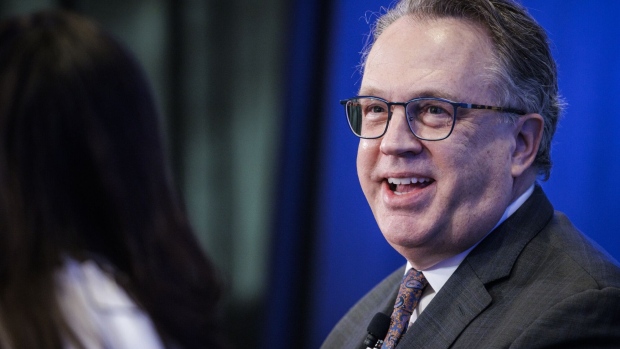May 30, 2024
High Interest Rates Are Working, Fed's Williams Says
, Bloomberg News

(Bloomberg) -- Federal Reserve Bank of New York President John Williams said he expects inflation to continue falling in the second half of this year, adding that elevated borrowing costs are restraining the economy.
Williams said that while inflation is still too high, Fed policy is well positioned and the imbalances between supply and demand are easing.
“With the economy coming into better balance over time and the disinflation taking place in other economies reducing global inflationary pressures, I expect inflation to resume moderating in the second half of this year,” Williams said Thursday in prepared remarks at the Economic Club of New York.
“The behavior of the economy over the past year provides ample evidence that monetary policy is restrictive in a way that helps us achieve our goals,” he said, adding later that a rate increase is unlikely.
In a moderated conversation following his remarks, Williams said he couldn’t say when he’d be likely to support a rate cut, emphasizing it depended on what incoming data told him about the economy.
“I don’t feel any urgency or need that we have to make a decision now,” he said.
Williams said he didn’t view recent price data as a sign that inflation is no longer heading lower. Williams said earlier this month that monetary policy is in a good place and he wants to see more evidence to be confident inflation is falling to the central bank’s target.
Data out earlier Thursday showed the US economy grew at a slower pace in the first quarter than initially reported, underscoring a loss of momentum at the start of the year. Monthly spending figures for April, along with the latest read on the Fed’s preferred inflation gauge, will be released Friday.
Read More: US GDP Growth Was Slower Last Quarter on Soft Consumer Spending
Williams said he sees inflation — as measured by the personal consumption expenditures price index — falling to about 2.5% by the end of this year before moving closer to 2% next year. He sees the unemployment rate reaching about 4% at the end of this year then falling toward 3.75%.
“How I think about it is, monetary policy is currently well positioned but we have also the time, and ability, given where the economy is, to collect more data,” Williams told reporters following the event, adding the US is on a “reasonably good track” to taming inflation without an economic downturn.
Fed officials have signaled interest rates likely need to stay elevated for longer as inflation cools more slowly than expected. US central bankers have left their benchmark rate in a target range of 5.25% to 5.5% since July. Policymakers will meet next on June 11-12.
“The policy that we put in place is working,” Williams said. “But, the view on what is the appropriate path for policy is adjusting with the change in the outlook.”
Neutral Rate
Williams also weighed in on a broader debate among officials and other economists over the so-called neutral rate. That’s the theoretical level at which a central bank’s benchmark interest rate would neither stimulate nor restrict the economy.
“The data we have through the first part of this year, there’s no sign of the neutral rate yet having risen,” he said. “Doesn’t mean it won’t.”
Speaking with reporters after the event, Williams added that the factors that have held interest rates down over the last decade are still in play, pointing to things like demographics and a willingness to hold US Treasuries.
Atlanta Fed President Raphael Bostic indicated last week that officials are rethinking their estimates of neutral and “there may be reasons to think the baseline steady state” is higher. Williams’ predecessor at the New York Fed, Bill Dudley, wrote earlier on Thursday he believed the neutral rate had risen substantially.
By contrast, Fed Governor Christopher Waller said he still thinks the neutral rate is relatively low.
Additional Policymakers’ Comments
Separately in an interview with CNN International broadcast Thursday, Chicago Fed President Austan Goolsbee flagged the importance of disinflation in housing costs in getting overall inflation back to the central bank’s 2% target. He also said he anticipates that further improvement in supply chains and in the labor force will help to damp headline price increases.
“The big outlier has been housing inflation,” with price rises elevated compared with pre-Covid times, Goolsbee said. “If we don’t get that inflation rate back down to something like what it was before, we’re going to have a hard time getting to 2%.”
During an interview on Fox Business, Atlanta Fed President Raphael Bostic said he expects slow progress in reducing inflation to the central bank’s 2% target. Bostic added he doesn’t think policymakers will lower borrowing costs in the next two months, saying “I don’t think that’s going to be in July.”
“But I’m data driven,” Bostic said. “If that data takes me to a place where I think the economy is sufficiently strong and inflation has moved sufficiently far that a cut is warranted, I would be open to that. But that is not my outlook today.”
--With assistance from Amara Omeokwe and Steve Matthews.
(Updates with comments from Bostic.)
©2024 Bloomberg L.P.





